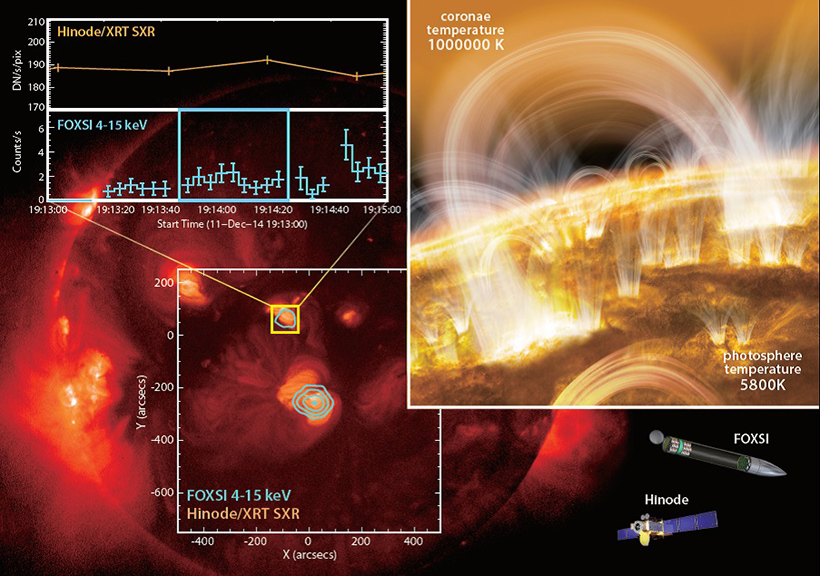JAXA | Detection of nanoflare-heated plasma in the solar corona
JAXA | Detection of nanoflare-heated plasma in the solar corona
An international research team led by Dr. Shin-nosuke Ishikawa (Project research fellow of JAXA) succeeded in detecting the subtle signs of nanoflares (tiny flares) in a region of the solar corona where no discernible flare activity was taking place. The finding was made by a combination of hard X-ray data from FOXSI (Focusing Optics X-ray Solar Imager) sounding rocket experiment and data from Hinode solar observatory. The frequent occurrence of nanoflares has been regarded as a promising agent for maintaining the solar corona at a high temperature of several million Kelvin. The result from the research group is expected to put strong constraints to theories accounting for the coronal heating.
[box type=”shadow” align=”aligncenter” class=”” width=””]
Title: Detection of nanoflare-heated plasma in the solar corona by the FOXSI-2 sounding rocket
Authors: Shin-nosuke Ishikawa, Lindsay Glesener, Säm Krucker, Steven Christe, Juan Camilo Buitrago-Casas, Noriyuki Narukage and Juliana Vievering
doi: 10.1038 / s41550-017-0269-z[/box]
There are several hypotheses for possible mechanisms of coronal heating. One of them assumes heating by the frequent occurrence of very tiny flares, nanoflares. This hypothesis has been regarded as promising for explaining the hot corona. With the nanoflare hypothesis, numerical studies have suggested the creation of very hot plasmas exceeding ten-million Kelvin which is by far hotter than the typical temperature of the corona.
Dr. Shin-nosuke Ishikawa’s international research group launched FOXSI sounding rocket for hard X-ray observation of the Sun and was successful in observing multiple coronal regions during its 6-minutes observation window during the rocket flight. FOXSI was realized under the international collaboration of state-of-the-art technologies; the X-ray optics for FOXSI was developed by U.S. colleagues of the team while Japanese members developed semi-conductor X-ray imaging detector of low-noise and fine pixel pitch. By analyzing data from FOXSI and Hinode XRT, the research team was able to estimate, with high accuracy, the temperature structure of the corona for the region observed. It became clear that, albeit small in its amount, there certainly existed very hot plasmas. The hard X-ray emission detected by the FOXSI observation was emitted for a quiet solar active region which was not showing X-ray brightening nor flaring activity.
This result strongly suggests the occurrence of nanoflares even in a region without apparent flaring activities. The finding is expected to pose a strong constraint on theoretical models explaining coronal heating. The research group succeeded in, not only confirming the persistent presence of very hot plasmas in the solar corona but also demonstrating the power of high sensitivity and high spatial resolution X-ray observations of the corona.
Publication: Nature Astronomy (2017)
Published online: 09 October 2017
Find new and coming technologies at our site: https://comingtechs.com. Please subscribe to our news form and add RSS to your favorite news reader.




Post Comment
You must be logged in to post a comment.